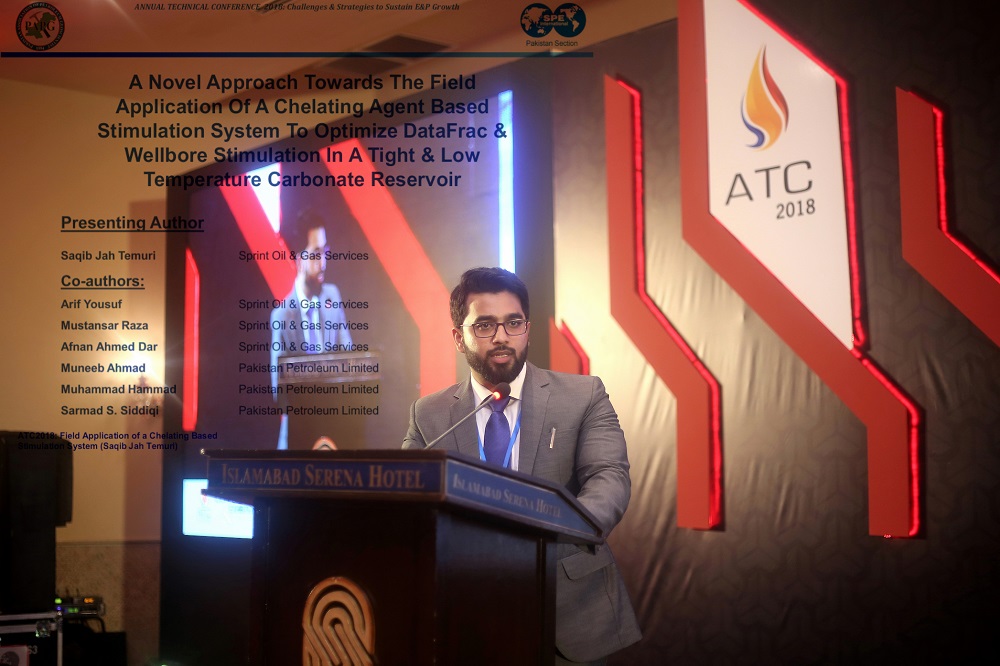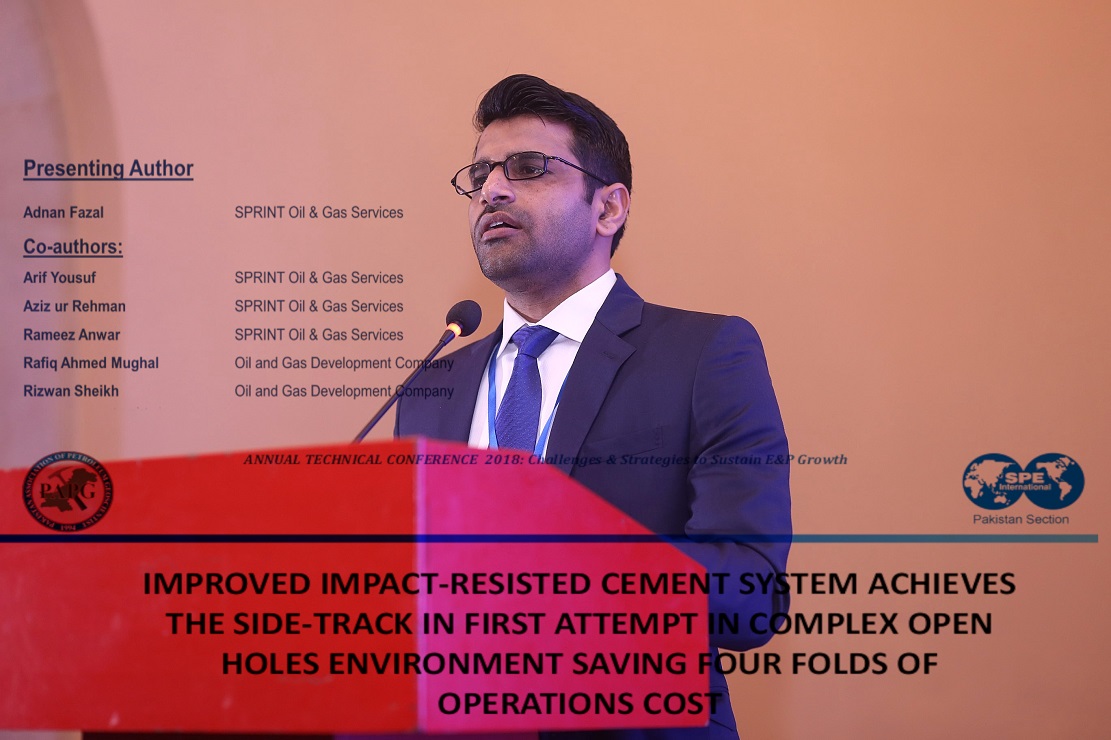Publications

Acid Prohibitive Flexible Cement Enables Long Term Zonal Isolation in High Temperature High Pressure WellSPE-203308-MS This paper was prepared for presentation at the Abu Dhabi International Petroleum Exhibition & Conference held in Abu Dhabi, UAE, from 9 to 12 of November 2020. Due to COVID-19, the physical event was changed to a virtual event. The official proceedings were published online on 9 November 2020. Cementing of production casing in the candidate field poses challenges to the cement sheath integrity due to mechanical and thermal stresses induced in the well life. The problem is further aggravated due to the narrow window between pore pressure and fracture gradient. The acid-prohibitive cement system with improved mechanical properties was developed to mitigate the effect of induced stresses. The job was executed with operational optimization and zonal isolation was achieved. Based on the operator's well testing and multi-stage high-rate well stimulation plan, the stress modeling was carried out to determine the optimum mechanical properties. The 19.6 ppg heavyweight cement system with a flexible thermoplastic polymer was designed to achieve the required Young's modulus and Poisson's ratio. The approach was implemented without any operational issues in the 9-7/8" production casing and 7" liner cementing. Following the job completion and waiting-on-cement time, the 9-7/8" casing was successfully pressure tested with a surface applied pressure of 2,000 psi and a well fluid of 1.78 SG. The isolation scanner cement evaluation confirmed the zonal isolation along the open hole of both the 9-7/8" intermediate casing and the 4½" production liner. Finally, the multi-stage high-pressure stimulation operations were performed during the completion/testing stage with no sign of communication between the different zones. The application of heavyweight acid prohibitive flexible slurry helped the operator to isolate the different zones of interest that were less than 10 m apart and retained the integrity of the seal throughout the high-pressure stimulation operation. Well is open to production without any annular pressure, thus, saving the operator's time and cost on the remedial cementing operations. |

Novel Approach Towards The Field Application Of A Chelating Agent Based Stimulation System To Optimize DataFrac & Wellbore Stimulation In A Tight & Low Temperature Carbonate ReservoirSPE-195665-MS, Presented at the PAPG/SPE Annual Technical Conference and Exhibition held in Islamabad, Pakistan, 10-12 December 2018. In matrix acidizing of carbonate formations, acids are used to create wormholes that connect the formation to the wellbore. Hydrochloric acid, formic or acetic acid, or mixtures of these acids are commonly used in matrix acidizing treatments of carbonate reservoirs. However, the use of these acids exhibits some major limitations including high and uncontrolled reaction rate, face dissolution and corrosion to the completion goods, especially those made of chrome-based tubulars (Cr-13 and duplex steel), and these problems become severe at elevated temperatures. This paper presents a case study of a post datafrac operation wherein a state-of-the-art stimulation system, based on a chelating agent, is deployed in a matrix stimulation treatment of a low temperature tight carbonate reservoir for the first-time in the country. The new stimulation fluid allows the operator to optimize datafrac and wellbore stimulation in a single treatment. The approach also aids the project to be cost-effective and financially feasible, particularly in a low-budgetary environment. Literature review comparing selected chelating agent and conventional acids is also described in this paper to support the approach adopted in abovesaid case study. |

Improved Impact-Resisted Cement System Achieves the Side-Track in First Attempt in Complex Open Holes Environment Saving Four Folds of Operations CostSPE-195662-MS, Presented at the PAPG/SPE Annual Technical Conference and Exhibition held in Islamabad, Pakistan, 10-12 December 2018. The operation of bypassing the existing borehole by placing a kick off cement plug has historically been very well established and long-standing technique. Although placement of a cement plug appears to be a routine and relatively simple job, the instances of kick off plug not fulfilling the desired purpose are quite frequent requiring same degree of planning as primary cement jobs. Traditional cement slurry systems for sidetracking have been focused on the development of compressive strength by reduced water content. These cements exhibit low resistance to impact and toughness requiring multiple attempts to side track the well. An industry average for kick-off plugs is 2.4 attempts per kick-off, with 24 hours rig time associated with each attempt. SPE-195662-MS, Presented at the PAPG/SPE Annual Technical Conference and Exhibition held in Islamabad, Pakistan, 10-12 December 2018. This paper describes the engineered slurry system that incorporates unique properties of higher impact resistance, fracture toughness and load bearing capacity which resulted in slow ROP and sidetrack in 1st attempt. The main conclusion was supported by a field case study. |

Production Optimization through Systematic Removal of Formation Damage, A Case Study of ENI Pakistan
SPE 15621, Presented at the SPE/PAPG Annual Technical Conference held in Islamabad, Pakistan, 22–23 November 2011.
Formation damage removal using matrix acid stimulation in Sandstone reservoir is recognized as a risky production optimization operation, however, a good understanding of formation mineralogy, root cause of formation damage, and stimulation procedures can help reduce the risk and increase the chance of success. The scope of this paper is to share Eni Pakistan’s workflow which lead to successful matrix acid stimulation campaigns in Bhit, Badhra and Kadanwari fields.
Prior to the damage removal operation, the selected wells’ deliverability analysis showed low productivity as compared to the ideal one. To restore the ideal wells’ productivity index, detailed damage analysis was performed. Seven candidate wells were selected for damage removal operation. The matrix stimulation operation resulted in incremental daily production of up to 160%. The increase in the production rate was accomplished by regaining the wells’ potential deliverability. This helped improve the fields’ reservoir management, accelerating hydrocarbon recovery and adding to the reserves.

Successful Approach of Scale Cleaning Using Organic Dissolvers To Delay Scale Re-Deposition at Pariwali Well # 5: A Case Study
SPE 142837, Presented at the SPE/PAPG Annual Technical Conference held in Islamabad, Pakistan, 10-11 November 2010.
Production drop caused by down hole scale deposition is a serious problem not only in wells producing with high water cut but also in deep, hot, sour gas wells with very low water cuts (trace to 6%).
This paper presents a case study of CaCO3 & CaSO4 scale deposition in a sour well in north of Pakistan that resulted in substantial production drop. HCl (15%) was used to dissolve/wash the scale obstruction in the tubular and clean the perforation of well. Although the treatment was successful in dissolving the scale and restoring the production, yet these production gains were lost rapidly. Scale dissolver treatments followed by scale inhibitions were also implemented but no appreciable results were achieved. A detailed in house study was carried out by POL for scale analysis and its removal techniques. Scale monitoring by produced water analysis, gauge cutter runs, production & WHFP fluctuations, gas analysis and review of seven scale cleaning jobs guided to carry out organic scale dissolving job.
Scale removal with organic dissolvers (Acetic acid) were recommended and proven successful because it maintained low pH which prevented re-precipitation of acid products. With this approach, scale re-deposition was delayed up to nine months.
